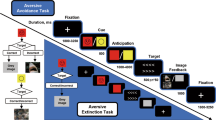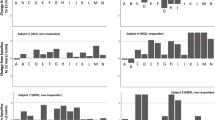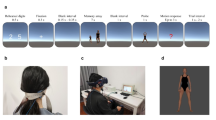Abstract
Gamma ventral capsulotomy (GVC) radiosurgery is intended to minimize side effects while maintaining the efficacy of traditional thermocoagulation techniques for the treatment of refractory obsessive–compulsive disorder (OCD). Neuropsychological outcomes are not clear based on previous studies and, therefore, we investigated the effects of GVC on cognitive and motor performance. A double-blind, randomized controlled trial (RCT) was conducted with 16 refractory OCD patients allocated to active treatment (n=8) and sham (n=8) groups. A comprehensive neuropsychological evaluation including intellectual functioning, attention, verbal and visuospatial learning and memory, visuospatial perception, inhibitory control, cognitive flexibility, and motor functioning was applied at baseline and one year after the procedure. Secondary analysis included all operated patients: eight from the active group, four from the sham group who were submitted to surgery after blind was broken, and five patients from a previous open pilot study (n=5), totaling 17 patients. In the RCT, visuospatial memory (VSM) performance significantly improved in the active group after GVC (p=0.008), and remained stable in the sham group. Considering all patients operated, there was no decline in cognitive or motor functioning after one year of follow-up. Our initial results after 1 year of follow-up suggests that GVC not only is a safe procedure in terms of neuropsychological functioning but in fact may actually improve certain neuropsychological domains, particularly VSM performance, in treatment refractory OCD patients.
Similar content being viewed by others
Log in or create a free account to read this content
Gain free access to this article, as well as selected content from this journal and more on nature.com
or
References
Anderson MJ (2001). A new method for non-parametric multivariate analysis of variance. Austral Ecol 26: 32–46.
Andrade L, Wang Y, Andreoni S (2012). Mental disorders in megacities: findings from the Sao Paulo megacity mental health survey, Brazil. PLoS One 7: e31879.
Beck AT, Epstein N, Brown G, Steer RA (1988). An inventory for measuring clinical anxiety: psychometric properties. J Consul Clin Psychol 56: 893–897.
Beck AT, Ward CH, Mendelson M, Mock J, Erbaugh J (1961). An inventory for measuring depression. Arch Gen Psychiatry 4: 561–571.
Belotto-Silva C, Diniz JB, Malavazzi DM, Valério C, Fossaluza V, Borcato S et al (2012). Group cognitive-behavioral therapy versus selective serotonin reuptake inhibitors for obsessive-compulsive disorder: a practical clinical trial. J Anxiety Disord 26: 25–31.
Benedict RHB, Schretlen D, Groninger L, Brandt J (1998). Hopkins verbal learning test—revised: normative data and analysis of inter-form and test-retest reliability. Clin Neuropsychol 12: 43–55.
Benton AL, Varney NR, Hamsher KD (1978). Visuospatial judgment. A clinical test. Arch Neurol 35: 364–367.
Binder DK, Iskandar BJ (2000). Modern neurosurgery for psychiatric disorders. Neurosurgery 47: 9–21; discussion 21–3.
Bloch MH, Landeros-Weisenberger A, Kelmendi B, Coric V, Bracken MB, Leckman JF (2006). A systematic review: antipsychotic augmentation with treatment refractory obsessive-compulsive disorder. Mol Psychiatry 11: 622–632.
Bloch MH, Sukhodolsky DG, Dombrowski Pa, Panza KE, Craiglow BG, Landeros-Weisenberger A et al (2011). Poor fine-motor and visuospatial skills predict persistence of pediatric-onset obsessive-compulsive disorder into adulthood. J Child Psychol Psychiatry 52: 974–983.
Csigó K, Harsányi A, Demeter G, Rajkai C, Németh A, Racsmány M (2010). Long-term follow-up of patients with obsessive-compulsive disorder treated by anterior capsulotomy: a neuropsychological study. J Affect Disord 126: 198–205.
Curtis CE (2006). Prefrontal and parietal contributions to spatial working memory. Neuroscience 139: 173–180.
Figee M, Luigjes J, Smolders R, Valencia-Alfonso C-E, van Wingen G, de Kwaasteniet B et al (2013). Deep brain stimulation restores frontostriatal network activity in obsessive-compulsive disorder. Nat Neurosci 16: 386–387.
Fodstad H, Strandman E, Karlsson B, West K (1982). Treatment of chronic obsessive compulsive states with stereotactic anterior capsulotomy or cingulotomy. Acta Neurochir (Wien) 62: 1–23.
Folstein MF, Folstein SE, McHugh PR (1975). ‘Mini-mental state’. A practical method for grading the cognitive state of patients for the clinician. J Psychiatr Res 12: 189–198.
Grisham JR, Anderson TM, Poulton R, Moffitt TE, Andrews G (2009). Childhood neuropsychological deficits associated with adult obsessive-compulsive disorder. Br J Psychiatry 195: 138–141.
Guy W (1976) Assessment Manual for Psychopharmacology —Revised. Clinical Global Impression Scale. Department of Health, Education and Welfare. Public Health Service, Alcohol, Drug Abuse, and Mental Health Administration: Rockville, MD, USA. pp 218–222.
Heaton RK, Chelune G, Talley J, Kay G, Curtiss G (1993) Wisconsin Card Sorting Test Manual–Revised and Expanded. Psychological Assessment Resourses Inc: Odessa, FL, USA.
Heaton RK, Chelune G, Talley J, Kay G, Curtiss G (2005) Teste Wisconsin de Classificação de Cartas: manual revisado e ampliado; adaptação e padronização brasileira Jurema Alcides Cunha et al. Casa do Psicólogo: São Paulo, Brazil.
Insel T, Cuthbert B, Garvey M, Heinssen R, Pine DS, Quinn K et al (2010). Research domain criteria (RDoC): toward a new classification framework for research on mental disorders. Am J Psychiatry 167: 748–751.
Kaplan E, Goodglass H, Weintraub S (2001) The Boston Naming Test, 2nd edn. Lippincott Williams & Wilkins: Philadelphia, PA, USA.
Kim M-S, Park S-J, Shin MS, Kwon JS (2002). Neuropsychological profile in patients with obsessive-compulsive disorder over a period of 4-month treatment. J Psychiatr Res 36: 257–265.
Kondziolka D, Flickinger JC, Hudak R (2011). Results following gamma knife radiosurgical anterior capsulotomies for obsessive compulsive disorder. Neurosurgery 68: 28–32; discussion 23–3.
Kuelz AK, Hohagen F, Voderholzer U (2004). Neuropsychological performance in obsessive-compulsive disorder: a critical review. Biol Psychology 65: 185–236.
Kuelz AK, Riemann D, Halsband U, Vielhaber K, Unterrainer J, Kordon A et al (2006). Neuropsychological impairment in obsessive-compulsive disorder—improvement over the course of cognitive behavioral treatment. J Clin Exp Neuropsychol 28: 1273–1287.
Lopes AC, de Mathis ME, Canteras MM, Salvajoli JV, Del-porto JA, Miguel EC (2004). Update on neurosurgical treatment for obsessive compulsive disorder. Rev Bras Psiquiatr 26: 62–66.
Lopes AC, Greenberg BD, Norén G, Canteras MM, Busatto GF, de Mathis ME et al (2009). Treatment of resistant obsessive-compulsive disorder with ventral capsular/ventral striatal gamma capsulotomy: a pilot prospective study. J Neuropsychiatry Clin Neurosci 21: 381–392.
Lopes AC, Greenberg BD, Canteras MM, Batistuzzo MC, Hoexter MQ, Gentil AF et al (2014). Gamma ventral capsulotomy for obsessive-compulsive disorder: a double-blind, randomized controlled trial. JAMA Psychiatry 88: 177–182.
Miguel EC, Lopes AC, Guertzenstein EZ, Calazas MEB, Teixeira MJ, Brasil MA (2004). Guidelines for neurosurgery of severe psychiatric disorders in Brazil: a preliminary proposal. Rev Bras Psiquiatr 26: 8–9.
Miotto EC, Sato J, Lucia MCS, Camargo CHP, Scaff M (2010). Development of an adapted version of the Boston Naming Test for Portuguese speakers. Rev Bras Psiquiatr 32: 279–282.
Nyman H, Andreewitch S (2001). Executive and cognitive functions in patients with extreme obsessive-compulsive disorder treated by capsulotomy. Appl Neuropsychol 8: 91–98.
Nyman H, Mindus P (1995). Neuropsychological correlates of intractable anxiety disorder before and after capsulotomy. Acta Psychiatr Scand 91: 23–31.
Osterrieth P (1944). Le test de copie d’une figure complexe. Arch Psychol 30: 206–356.
Penadés R, Catalán R, Andrés S, Salamero M, Gastó C (2005). Executive function and nonverbal memory in obsessive-compulsive disorder. Psychiatry Res 133: 81–90.
Purcell R, Maruff P, Kyrios M, Pantelis C (1998). Cognitive deficits in obsessive-compulsive disorder on tests of frontal-striatal function. Biol Psychiatry 43: 348–357.
Rao NP, Reddy YCJ, Kumar KJ, Kandavel T, Chandrashekar CR (2008). Are neuropsychological deficits trait markers in OCD? Prog Neuropsychopharmacol Biol Psychiatry 32: 1574–1579.
Rauch SL, Jenike MA, Alpert NM, Baer L, Breiter HC, Savage CR et al (1994). Regional cerebral blood flow measured during symptom provocation in obsessive-compulsive disorder using oxygen 15-labeled carbon dioxide and positron emission tomography. Arch Gen Psychiatry 51: 62–70.
Rück C, Andréewitch S, Flyckt K, Edman G, Nyman H, Meyerson Ba et al (2003). Capsulotomy for refractory anxiety disorders: long-term follow-up of 26 patients. Am J Psychiatry 160: 513–521.
Rück C, Karlsson A, Steele JD, Edman G, Meyerson BA, Ericson K et al (2008). Capsulotomy for obsessive-compulsive disorder: long-term follow-up of 25 patients. Arch Gen Psychiatry 65: 914–921.
Ruscio AM, Stein DJ, Chiu WT, Kessler RC (2010). The epidemiology of obsessive-compulsive disorder in the National Comorbidity Survey Replication. Mol Psychiatry 15: 53–63.
Savage CR, Baer L, Keuthen NJ, Brown HD, Rauch SL, Jenike MA (1999). Organizational strategies mediate nonverbal memory impairment in obsessive-compulsive disorder. Biol Psychiatry 45: 905–916.
Segalàs C, Alonso P, Labad J, Jaurrieta N, Real E, Jiménez S et al (2008). Verbal and nonverbal memory processing in patients with obsessive-compulsive disorder: its relationship to clinical variables. Neuropsychology 22: 262–272.
Shin NY, Lee TY, Kim E, Kwon JS (2013). Cognitive functioning in obsessive-compulsive disorder: a meta-analysis. Psychol Med 1–10.
Singer JM, Poleto FZ, Rosa P (2004). Parametric and nonparametric analyses of repeated ordinal categorical data. Biometric J 46: 460–473.
Strauss E, Sherman E, Spreen O (2006) A compendium of neuropsychological tests: Administration, Norms, and Commentary. Oxford University Press: New York, NY, 1216.
Taub A, Lopes AC, Fuentes D, D’Alcante CC, de Mathis ME, Canteras MM et al (2009). Neuropsychological outcome of ventral capsular/ventral striatal gamma capsulotomy for refractory obsessive-compulsive disorder: a pilot study. J Neuropsychiatry Clin Neurosci 21: 393–397.
Wechsler D (1987) Manual for the Wechsler Memory Scale—Revised. The Psychological Corporation: San Antonio, TX, USA.
Wechsler D (1999) Wechsler abbreviated scale of intelligence (WASI). The Psychological Corporation: San Antonio, TX, USA.
Acknowledgements
This work received financial support from the Foundation for the Support of Research in the State of São Paulo (FAPESP, Brazil) grants no. 2005/55628-08, 2008/10257-0, 2009/09949-8, 2011/21357-9 and no. 2011/51485-9) and from the National Council for Scientific and Technological Development (CNPq, Brazil, grant no. 302463/2011-9). Some results from this study have been previously presented in poster form at the 69th Meeting of the Society of Biological Psychiatry in New York, NY (2014). Clinical trial registration: Radiosurgical Treatment for Obsessive–Compulsive Disorder; ClinicalTrials.gov Identifier: NCT01004302.
Author information
Authors and Affiliations
Corresponding author
Additional information
Supplementary Information accompanies the paper on the Neuropsychopharmacology website
PowerPoint slides
Rights and permissions
About this article
Cite this article
Batistuzzo, M., Hoexter, M., Taub, A. et al. Visuospatial Memory Improvement after Gamma Ventral Capsulotomy in Treatment Refractory Obsessive–Compulsive Disorder Patients. Neuropsychopharmacol 40, 1837–1845 (2015). https://doi.org/10.1038/npp.2015.33
Received:
Revised:
Accepted:
Published:
Issue date:
DOI: https://doi.org/10.1038/npp.2015.33
This article is cited by
-
Cognitive outcomes following functional neurosurgery in refractory OCD patients: a systematic review
Neurosurgical Review (2023)
-
Gamma knife capsulotomy for intractable OCD: Neuroimage analysis of lesion size, location, and clinical response
Translational Psychiatry (2023)
-
Cognitive performance in children and adolescents at high-risk for obsessive-compulsive disorder
BMC Psychiatry (2020)
-
Evolution of gamma knife capsulotomy for intractable obsessive-compulsive disorder
Molecular Psychiatry (2019)



